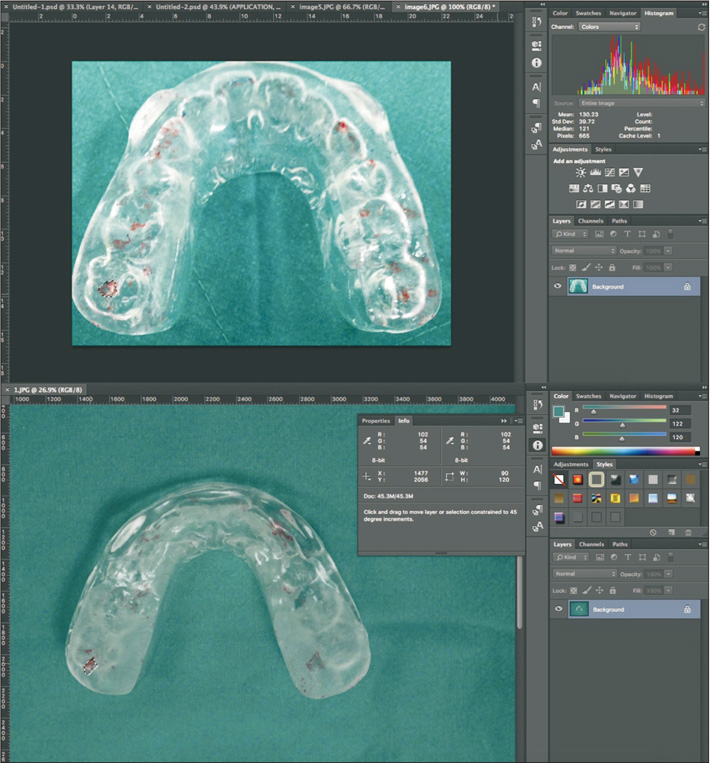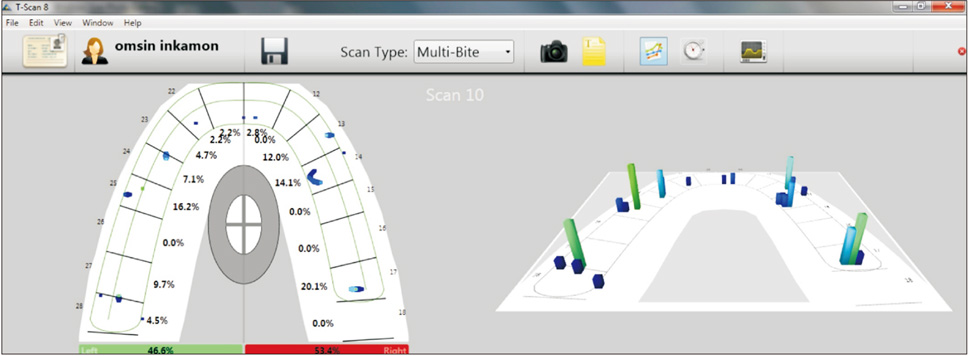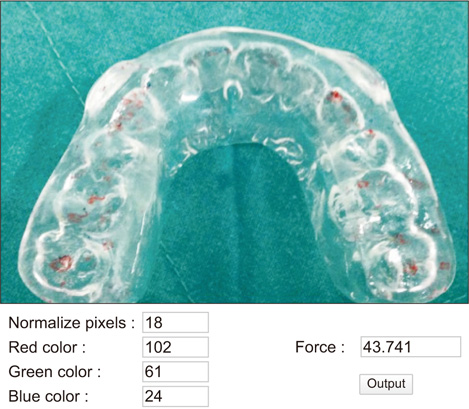Healthc Inform Res.
2017 Oct;23(4):255-261. 10.4258/hir.2017.23.4.255.
Clinical Decision Support Model to Predict Occlusal Force in Bruxism Patients
- Affiliations
-
- 1Department of General Dentistry, Faculty of Dentistry, Srinakharinwirot University, Bangkok, Thailand.
- 2Faculty of Dentistry, Thammasat University, Bangkok, Thailand. ppeetakul@hotmail.com
- KMID: 2396416
- DOI: http://doi.org/10.4258/hir.2017.23.4.255
Abstract
OBJECTIVES
The aim of this study was to develop a decision support model for the prediction of occlusal force from the size and color of articulating paper markings in bruxism patients.
METHODS
We used the information from the datasets of 30 bruxism patients in which digital measurements of the size and color of articulating paper markings (12-µm Hanel; Coltene/Whaledent GmbH, Langenau, Germany) on canine protected hard stabilization splints were measured in pixels (P) and in red (R), green (G), and blue (B) values using Adobe Photoshop software (Adobe Systems, San Jose, CA, USA). The occlusal force (F) was measured using T-Scan III (Tekscan Inc., South Boston, MA, USA). The multiple regression equation was applied to predict F from the P and RGB. Model evaluation was performed using the datasets from 10 new patients. The patient's occlusal force measured by T-Scan III was used as a "˜gold standard' to compare with the occlusal force predicted by the multiple regression model.
RESULTS
The results demonstrate that the correlation between the occlusal force and the pixels and RGB of the articulating paper markings was positive (F = 1.62×P + 0.07×R -0.08×G + 0.08×B + 4.74; R 2 = 0.34). There was a high degree of agreement between the occlusal force of the patient measured using T-Scan III and the occlusal force predicted by the model (kappa value = 0.82).
CONCLUSIONS
The results obtained demonstrate that the multiple regression model can predict the occlusal force using the digital values for the size and color of the articulating paper markings in bruxism patients.
Keyword
MeSH Terms
Figure
Reference
-
1. Chae YM, Yoo KB, Kim ES, Chae H. The adoption of electronic medical records and decision support systems in Korea. Healthc Inform Res. 2011; 17(3):172–177.
Article2. Lavigne GJ, Manzini C, Kato T. Sleep bruxism: principles and practice of sleep medicine. 4th ed. Philadelphia (PA): Elsevier/Saunders;2005.3. Kato T, Thie NM, Huynh N, Miyawaki S, Lavigne GJ. Topical review: sleep bruxism and the role of peripheral sensory influences. J Orofac Pain. 2003; 17(3):191–213.4. Castrillon EE, Ou KL, Wang K, Zhang J, Zhou X, Svensson P. Sleep bruxism: an updated review of an old problem. Acta Odontol Scand. 2016; 74(5):328–334.
Article5. Lobbezoo F, Van Der Zaag J, Naeije M. Bruxism: its multiple causes and its effects on dental implants: an updated review. J Oral Rehabil. 2006; 33(4):293–300.
Article6. Harada T, Ichiki R, Tsukiyama Y, Koyano K. The effect of oral splint devices on sleep bruxism: a 6-week observation with an ambulatory electromyographic recording device. J Oral Rehabil. 2006; 33(7):482–488.
Article7. Okeson JP. The effects of hard and soft occlusal splints on nocturnal bruxism. J Am Dent Assoc. 1987; 114(6):788–791.
Article8. Kurita H, Ikeda K, Kurashina K. Evaluation of the effect of a stabilization splint on occlusal force in patients with masticatory muscle disorders. J Oral Rehabil. 2000; 27(1):79–82.
Article9. Holmgren K, Sheikholeslam A, Riise C. Effect of a fullarch maxillary occlusal splint on parafunctional activity during sleep in patients with nocturnal bruxism and signs and symptoms of cranio-mandibular disorders. J Prosthet Dent. 1993; 69(3):293–297.
Article10. Dylina TJ. A common-sense approach to splint therapy. J Prosthet Dent. 2001; 86(5):539–545.
Article11. Braun S, Bantleon HP, Hnat WP, Freudenthaler JW, Marcotte MR, Johnson BE. A study of bite force. Part 1: Relationship to various physical characteristics. Angle Orthod. 1995; 65(5):367–372.12. Dawson PE. Functional occlusion: from TMJ to smile design. St Louis (MO): Mosby;2007. p. 347. p. 610.13. Qadeer S, Kerstein R, Kim RJ, Huh JB, Shin SW. Relationship between articulation paper mark size and percentage of force measured with computerized occlusal analysis. J Adv Prosthodont. 2012; 4(1):7–12.
Article14. Kerstein RB, Lowe M, Harty M, Radke J. A force reproduction analysis of two recording sensors of a computerized occlusal analysis system. Cranio. 2006; 24(1):15–24.
Article15. Keith TZ. Multiple regression, beyond: an introduction to multiple regression and structural equation modeling. New York (NY): Taylor & Francis;2015.16. Attanasio R. Nocturnal bruxism and its clinical management. Dent Clin North Am. 1991; 35(1):245–252.
Article17. Nishigawa K, Bando E, Nakano M. Quantitative study of bite force during sleep associated bruxism. J Oral Rehabil. 2001; 28(5):485–491.
Article18. Kerstein RB, Radke J. Clinician accuracy when subjectively interpreting articulating paper markings. Cranio. 2014; 32(1):13–23.
Article
- Full Text Links
- Actions
-
Cited
- CITED
-
- Close
- Share
- Similar articles
-
- Evaluation of the effect of two different occlusal splints on maximum occlusal force in patients with sleep bruxism: a pilot study
- Implant complications in bruxism patients
- Differences in Psychological Changes after Botulinum Toxin A Administration for Bruxism with Masseter Hypertrophy
- Changes of bite force and dynamic functional occlusion analysis after occlusal stabilization splint therapy in sleep bruxism patients: a pilot study
- Occlusal force evaluation and its clinical implication in dental clinics





